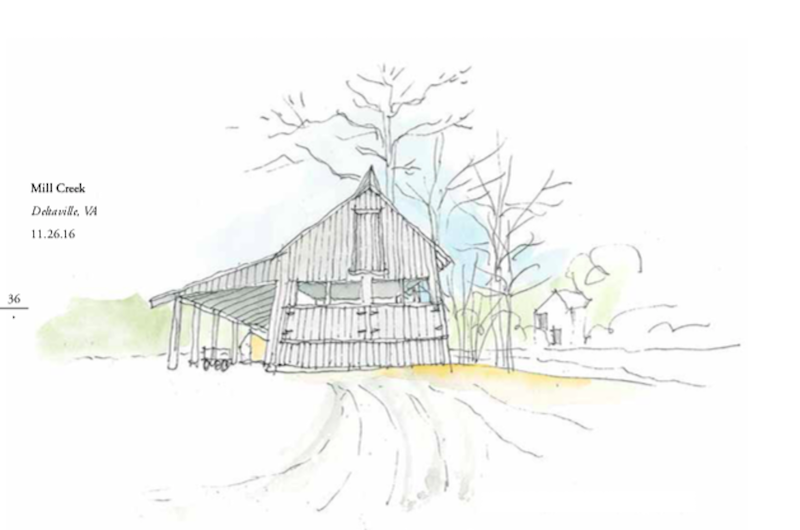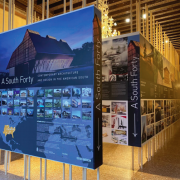Frank Harmon, his buildings and principles, are on display now in the exhibition “A SOUTH FORTY: Contemporary Architecture and Design in the American South” in Venice, Italy

“Across the architectural profession, Frank Harmon, FAIA, is the face of North Carolina architecture…[He] has brought to a national audience a glimpse of the unique character and architectural culture of his home state.”
Architect Jeffrey Lee, FAIA, wrote that assessment in his letter to nominate Frank for the 2013 NCAIA Gold Medal. This year, Frank and the work he produced in his former firm Frank Harmon Architect (he is now retired) are included in a special exhibition coinciding with the 2021 Venice Architecture Biennale entitled “A SOUTH FORTY: Contemporary Architecture and Design in the American South.” The exhibition is installed in the Great Hall at Palazzo Mora in Venice, Italy.
The Venice Biennale, Italian Società di Cultura la Biennale di Venezia, is an international art exhibition featuring architecture, visual arts, cinema, dance, music, and theater. It is held in the Castello district of Venice every two years during the summer. On the preview days, 25,000 artists, collectors, curators, museum directors, and journalists attend, followed by 600,000 visitors in the months after.
The Fay Jones School of Architecture & Design at the University of Arkansas, along with the literary journal Oxford American and modus studio in Fayetteville, AR, organized A SOUTH FORTY “to provide an overview of the current vitality of contemporary architecture and design in the American South…” by looking at the work and principles of architects who practice in the region.”
The criteria for a regional architect’s work to be included in the exhibition reads like a brief narrative of Frank’s projects and the principles that guided him: “…place-based design, attentive to the necessities of climate, materials, labor, and purpose, but also attentive to overlooked or undervalued typologies, constituencies, and locales.”
Awakening
Frank credits his friend and mentor, the late Harwell Hamilton Harris, with his professional osmosis from a modernist architect to a modern regionalist architect who embraces the environmentally sustainable principle of designing houses and buildings based on the context, customs, climate, geology, geography, and topography in a particular region. Regionally appropriate structures use regionally practical materials and feature elements specific to climatic needs.
Harris moved to Raleigh from California in 1962 to teach at NC State University’s School of Design (now College of Design). According to Frank, Harwell taught his students that the most important assets of a region are “its free minds, its imagination, its stake in the future, its energy, and, last of all, its climate, its topography, and the particular kind of sticks and stones it has to build with.”
Frank, in turn, has shared this wisdom with his own architecture students at NC State (some are included in the Venice exhibition), with interns and staff in his former firm, and with fellow practitioners through multiple seminars at state, regional, and national AIA conventions.

From his book Native Places: Drawing as a Way to See — Frank’s sketch of an old barn in Deltaville, VA.
Along with Harwell Harris’s influence, Frank credits his study of vernacular architecture, especially old barns and farmhouses throughout the rural South, with his dedication to sustainable, regionally appropriate design. “I’ve learned more about architecture from studying old barns than I ever did in a classroom,” he tells his audiences.
A prime example of his regionally appropriate methodology is the multi-award-winning Iron Studio that Frank designed for the Penland School of Arts & Crafts in the North Carolina mountains in 2000. That project was featured in Architectural Record in 2014 and is showcased in A SOUTH FORTY.
The Venice Biennale runs through November 21. For more information, click here.
To see a full gallery of Frank’s work, visit www.frankharmon.com.

